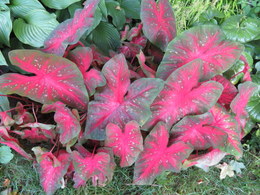Caladium Growing Guide
Caladium (Caladium spp.) is a tropical perennial native to South and Central America and will do well in USDA Zones 9 to 10. In colder areas they are grown as annuals. They should be planted in the spring after the last frost and the soil has warmed up. It prefers full shade to part sun.
The beautiful heart-shaped leaves in shades of reds, pinks or white will add a lot of color to your flower garden or that shady area that looks so bare.
In late winter look for them in garden centers. Look for large, firm tubers, rejecting any that are shriveled and have started growing due to the warm conditions they are in. When you see them, buy them and store in a cool, dark location where they can be kept in a dormant state. Depending on where you live you might be buying them in March and holding them until early June when the ground warms up.
Caladium will also make colorful houseplants and grow very well in pots and planters.
The next time you are in a garden center and see a large display of caladiums, pick up a few to brighten up the shady spot on your garden.
Soil Preparation
Plant your caladium in full shade to part sun in a nice loose well-drained garden soil. As soon as the soil is frost-free and can be worked, till the soil by digging down 8 to 12-inches turning the soil over with a garden fork. Remove any large rocks and stones. The small stones remaining will do no harm and actually benefit the soil by adding some micronutrients to the soil. They love shady locations and the leaves may scorch if exposed to the hot afternoon sun.
When to Plant
They should be planted outdoors in the late spring well after the last expected frost. If planted too early they may rot. Soil temperature is important when planting outdoors. The best time is when the night time temperatures reach 60-degrees F and the soil temperature reaches 60 to 70-degrees F.
Planting Caladiums
Follow the grower’s planting instructions. Plant the tubers 2 to 3-inches deep with the growing eyes or bud tips up. Spacing depends on the variety, but in general they can be planted 12 to 18-inches apart.
Water the soil around the tubers, adding more soil if necessary and water again. Water daily tapering off as the plant grows and gets established.
Watering and Care
They are low maintenance and easy to care for. All you need to do is add a layer of mulch to help retain moisture and keep out competing weeds. They should get an inch of water each week and during dry spells give some water to keep the soil moist. A light side dressing of organic fertilizer can be placed around the plant in the spring and during the growing season they can be given few applications of a balanced water soluble fertilizer.
In the fall when cooling temperatures cause the leaves to yellow and fall over the tubers can be dug up and lifted from the ground. Put the tubers in a warm dry location to let them dry out and go dormant. Cut off the dried foliage and shake off any excess soil. Place the tubers in a box with peat moss and store over the winter in a cool, dry location.
In the spring look them over and discard any dry shriveled tubers. The tubers can be divided making sure that each has an eye. Keep them dormant until you are ready to plant them.
Diseases and Pests
Caladium does not have any serious disease or pest problems. If you see any holes in the leaves it may be from slugs. Inspect the leaves early in the morning and remove any slugs by hand picking them.
Popular Caladium Varieties
Popular Varieties: Burning Heart, Florida Cardinal, Florida Fantasy, Florida Moonlight, Freida Hemple, John Peed, Pearl Blush, Red Flash, Red Ruffles, Rosebud, White Christmas, White Queen.
Sources: American Meadows, Eden Brothers, White Flower Farm
Garden Spikes newsletters give you timely information once or twice a month. Subscribe Free to the Garden Times newsletter below.
Your email address will only be used to send you a newsletter and will never be sold. You can unsubscribe at any time.

